Meg Mackintosh Solves Seven American History Mysteries (14 page)
Read Meg Mackintosh Solves Seven American History Mysteries Online
Authors: Lucinda Landon

“Peter, this is hopeless,” said Meg as she gazed over his shoulder. “Let's try a different tactic.”
“Not so fast, Meg-o. Look at this listing,” said Peter.
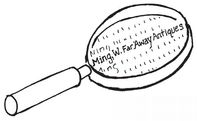
What did Peter notice?
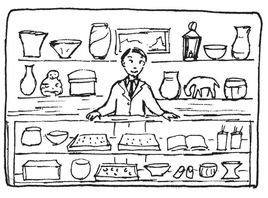
“
W. Ming Far Away Antiques!
Do you suppose there's a connection?” asked Peter, jotting down the address.
“It's in Chinatown. It can't be too far away,” Meg answered him, and they set off in search of the antique shop.
A few minutes later, they found it. A bell gently rang as they pushed open the door and entered the store.
Meg gazed around the dimly lit room. “So much neat stuff!”
Gramps pointed to some pictures on the wall. “Here are some very old photographs of men working on the railroad.”
“Conditions don't look very good,” said Meg. “They worked all winter, even in the snow.”
“That's true,” said a young man behind the counter. “The working conditions were deplorable, and the Chinese who built the railroad worked fourteen-hour days and were only paid $28 a month.”
“I read about that,” said Peter. “The Central Pacific Railroad was in a hurry to connect with the Union Pacific Railroad to become the first transcontinental railway.”
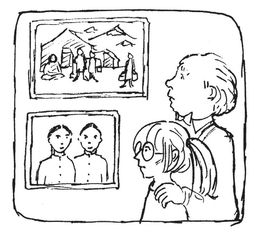
“So they worked all winter to complete the job. They went on strike for better wages, but the owners cut off their food supply until they began work again,” the young man added.
“That's awful,” said Meg.
“Strike?!” cried Peter. “Let's see that clue again.”
Meg pulled the clue out of her knapsack and the lantern too. She read the end of the clue aloud:
“Far-away brother lost the strike, city brother saved the spike.”
“Could I please see your lantern?” asked the young man.
What did he notice?
Meg handed over the lantern. Then something on the shelf caught her eye. “Look! It's a lantern like ours!”
“Exactly what I noticed,” said the young man as he took down the second lantern.
“They're twins,” confirmed Peter. “The both have the same mark.”
“Where did you find this?” asked the young man.
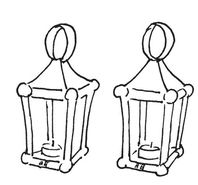
“It's a long story, but we have been searching for a twin,” said Meg. “I thought we were looking for a twin brother, but we found a twin lantern!”
Peter briefly explained about Professor Brown's history mysteries, and Meg showed the young man the riddle and the clue that was hidden inside the lantern.
“Professor Brown must have known that you had the matching lantern,” said Gramps. “It's lucky it wasn't sold.”
“It's not for sale,” said the young man. “It has a special meaning to my family. My name is Wesley Ming. This is my family's store. The lantern is a reminder of the hard work my ancestors did when they came to this country. And you
were
looking for a pair of twin brothers, my great-great uncles. You were looking at their photograph a moment ago, Xu Ming and Kam Ming.”
“The twin bothers had twin lanterns!” said Peter as he held them up. “That's odd, your lantern is much heavier. I mean a lot heavier.” He handed the lanterns to Wesley to judge.
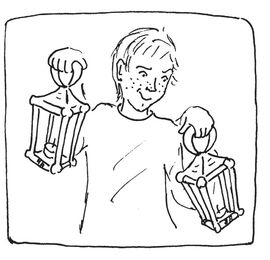
“You're right. Even though they seem to be identical,” said Wesley.
“Peter, that's it!” said Meg “You just solved this history mystery!”
What is Meg getting at?
“I bet there's something hidden inside of your lantern, too,” said Meg. “I'll show you.” She carefully turned the lantern over and removed the piece on the bottom like she had before. A heavy shiny object slid out.
“What is it?” asked Gramps.
“It's gold!” exclaimed Peter. “No wonder it was so heavy!”
“It looks like a gold spike. Like the spikes they drove into the railroad ties,” said Wesley. “And there's a piece of paper with a message.” He translated, “
Brothers switch places.
I can't believe this has been found! It's from my twin uncles!”
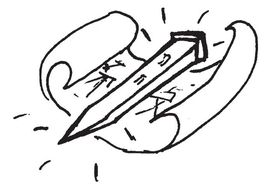
“That's like the message we had, only ours said,
Brothers switch lanterns
,” explained Peter.
“They switched lanterns and places? What's this all about?” asked Meg.
“The story is that Kam Ming went to work on the railroad and Xu stayed behind in San Francisco,” said Wesley. “When Xu heard about the strike, he sneaked into the camp to make sure his brother was okay, carrying the lantern to find his way. Maybe he brought food and clothing. When he found his brother in poor health, Xu switched places with Kam and sent him back to San Francisco â they were identical twins, so no one noticed.”
“But why did they switch lanterns too?” Peter asked.
“The lanterns held the messages. The old family must have known about the secret hiding places. If something happened to either of them, the message would explain. A Chinese worker always would return the lantern to the Ming family,” said Wesley.
“Kam, the twin on the railroad brought the golden spike back with him,” he concluded. “Chinese workers often made precious things out of the gold they had mined and hid the items to get them back to China.”
“A narrow spike fit into the hollow hiding place,” said Meg.
“It's also like the golden spike that they drove in when they connected the two railroads at Promontory Point!” added Peter.
“Only this spike commemorates the Chinese workers!” said Wesley proudly. “These are small signatures of workers on the spike â my ancestors and their friends! I'm so glad you found me. I never would have known the spike was hidden in here.”
“Now the twin lanterns have found each other,” said Meg.
“They make a nice pair,” added Peter.
“So near and yet so far away,” mused Gramps, as he gave Meg and Peter a hug. “Case closed.”
“
Cases
closed,” said Meg. “We solved the seven history mysteries.”
“We still have to drive all the way home,” said Peter. “There is still more to see.”
“And there is always another mystery on the horizon,” said Meg with a smile.
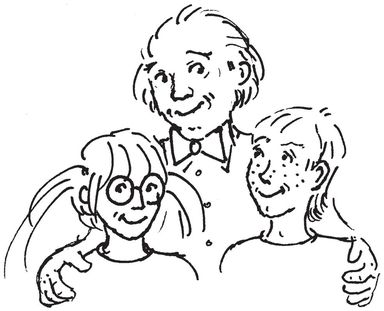
Peril at Plimoth
â Who Were the Pilgrims?
Pose the following research questions. Who were the Pilgrims and why did they come to America? After students complete their research, challenge them to present their findings in creative ways, for instance, as a time-travel interview with a Pilgrim or a web site.
The Minuteman's Secret
â “Child's Play”
What kinds of games did children play in colonial America? What songs did they sing during the American Revolution? What types of arts and crafts did children do? Young readers can be urged to research Amercan games, songs, and arts and crafts of the 1700s â and then use their research to plan and hold a Revolutionary Days Fair.
Witness at Washington
â Town Time Capsule
Many people had a hand in designing our nation's capital. Who was instrumental in founding, designing, and building the reader/student' own community? They can research for the information and then, for example, create a time capsule that records their community's history.
The Camouflage Clue in Ohio
â Portrait of Harriet Tubman
Who was Harriet Tubman? What prompted her to help others? Young readers can be encouraged to research the life of Harriet Tubman and then present their findings in the form of a short story, a play, a poem, or a song.
The Warning at Scottsbluff
â Obstacles on the Oregon Trail
What geographical obstacles stood in the way of settlers on the Oregon Trail? Students can make physical maps showing the route of the Oregon Trail and then consider how geography would have affected travelers â and how warning signs might have been placed.
The Puzzle at Pecos
â Family Artifacts
Young readers may be urged to think of artifacts that have been passed down in their own families. Then they may write descriptions of their artifacts and tell about their importance to them and to their families.
The San Francisco Riddle
â Strike it Rich
Encourage young readers to imagine that they had joined the gold rush to California. Ask them to choose a number: 1 or 2. Explain that 1 means they struck it rich, but 2 means they went broke. Suggest that students write letters home describing their successes or their lack of luck.
